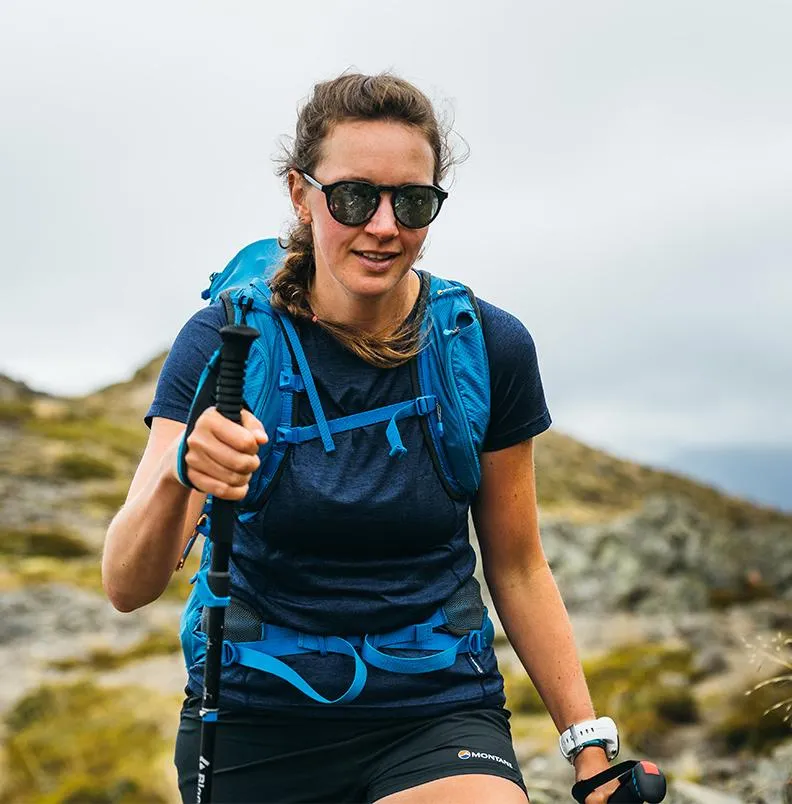Made great progress with your running over the summer and don't want to lose your gains? Montane ambassador, adventurer and ultra endurance runner Jenny Tough shares her top tips for maintaining momentum over the cold winter months.
With the long, warm summer evenings now behind us, so too are the sunny late evening runs. Despite the change in temperature, many of us will fight the urge to sit by the fire and continue to maintain the hard-won gains of last season. But before you set out its key that you make some subtle changes to make the most of winter running safely.
Jenny Tough is an adventurer and endurance athlete that's currently on a mission to run across a mountain range on every continent, so it's fair to say she's more than qualified to share some advice on running in the cold. Here are her 10 winter running tips to bear in mind before lacing up your trainers in these colder conditions.
1. Firstly, make sure you still go running in winter!
There are numerous mental and physical benefits to maintaining exercise throughout the seasons. Don’t let the dark nights put you off.
2. Layering and ventilation are everything
Ensure you're wearing suitable clothing that'll keep you warm enough while preventing overheating. A Gore-Tex layer on top will provide lightweight, breathable, and weatherproof protection for the duration of your run. The Montane Fleet Waterproof Jacket is a key piece of kit that I use and is one of the best available. It comes in both a male and female version.
3. Be seen in the dark
Make sure you use lights, such as a head torch, and choose clothing that has reflective panels. You need to ensure you can see where you're running while being visible to others; this'll help reduce the chances of any avoidable collisions, trips or falls while allowing you to focus on your run without struggling for vision.
4. Get a grip
If running in a snowy area, get some grips for your shoes. Ice is arguably the main peril of winter running, especially when moving at higher speed, and always be careful when temperatures are set to fluctuate, creating ice unexpectedly. If you're in any doubt about the surface you’re running on, then slow down – the slower you're running the less momentum you will have if you fall.
5. Protect your eyes

It's vital to ensure your vision is at an optimal level when running in dangerous conditions. Getting snow or rain in your eyes can lead to blurred vision, which can easily lead to a slip or a trip. Running sunglasses or even ski goggles offer an effective solution.
6. Be prepared on longer runs
Carry a spare jacket and hat in a pack. This is important because if for any reason you need to stop, you will need to ensure you stay warm. Your body temperature can quickly drop and if your legs begin to cramp up, too, you may be in a sticky spot.
You can never be too prepared! The Montane Unisex Podium Waterproof Pull-On Jacket is a packable and efficient jacket to stave off the cold and rain.
7. Wool or waterproof socks are your best friends
These are highly recommended and will keep your feet both warm and dry. It’s important to ensure your feet are warm and as comfortable as possible. Uncomfortable feet can lead to pain and blisters, which are a large obstacle to an enjoyable run!
8. Pick your time
The snow always has the best grip in the morning as it freezes overnight, so it can be a better and safer time to run. The more grip the better, as it will lead to a safer, more enjoyable run. And, after all, who doesn’t love a morning run?
9. Try high-intensity workouts
When it's very cold, do shorter, high-intensity workouts to stay warm and avoid exposure. In winter, sweat can become a real problem as the moisture on your skin and clothes can freeze, causing you to feel much colder and your body temperature to drop.
10. Dry out your shoes as you get home
There are few things worse than running in wet shoes. It can quickly lead to discomfort and blisters, which you will want to avoid. Get into a routine of drying out your shoes just after your run. To do this, try stuffing your shoes with newspaper and leaving them in a warm room away from direct heat sources.
Ultimately, running in winter brings with it different challenges and sensations. Some prefer running in winter and enjoy pushing themselves in the tougher, darker, more extreme conditions. However, it's important that runners are fully aware of the dangers faced when running in winter, as one wrong decision or oversight can result in injury. That said, get out there, be safe and enjoy!
Jenny Tough is a Montane ambassador, fast packer, and endurance challenger, and can be found on Instagram at @jennytough.